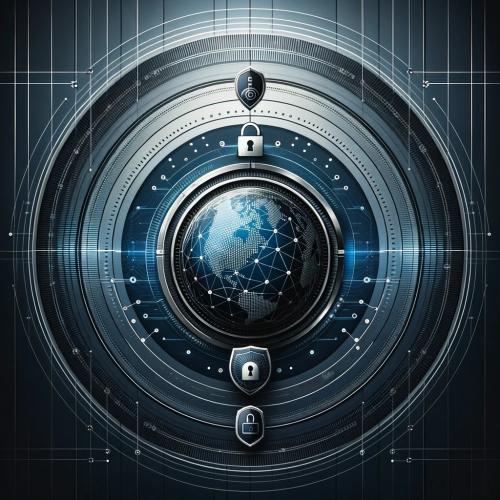Copy Link
Add to Bookmark
Report
COMSEC Draft Glossary

DRAFT GLOSSARY OF COMMUNICATIONS SECURITY TERMS
PREPARED BY THE COMSEC ASSOCIATION and ROSS ENGINEERING
February 24, 1990
301-670-0512 (voice)
202-364-1304 (BBS)
ANI. Automatic Number Identification
CNA. Customer Name and Address. This is a telephone company facility in this
country by which telephone companies help one another by providing the name
and address of a customer whose number is known. It is used widely by
investigators in the practice of their profession.
LLLTV. Low Light Level Television
SCIF. Secure Compartmentalized Information Facility. It is a facility that
is built to government specifications that assures that what is said in the
room is heard only by the people in the room.
STU III. Secure Telephone Unit number three (pronounced "stew three"). AT&T,
Motorola and RCA are building these after a government sponsored development.
They are secure telephones to be used by government contractors when talking
about sensitive information over the telephone.
TELCO. Telephone Company.
TELEPHONE INSTRUMENT. The complete telephone set, including handset, ringer,
dialing mechanism, etc.
TELEPHONESE. This is a special language spoken by telephone company people.
Some of the words in this language are necessary to properly communicate in
this specialized area. Some, however, seem to have been chosen for the
purpose of obfuscation.
An example of a necessary telephonese expression is "SMDR" which stands for
"station message detail recorder", an accurate description of the purpose and
function of the device.
An example of a word which seems to be intended to confuse or obfuscate is
"transmitter". We all know that a transmitter is something which transmits,
but the phone company people use this word when referring to a carbon
microphone, a device which is totally passive and has no ability to transmit
anything.
Another word which can cause serious misunderstanding is "bridge". Those of
us who have studied electronics know that a bridge is a four-terminal device
which has many useful applications. Unfortunately, the phone company people
use this word when they are describing a simple two-wire parallel connection.
The reason for their choice of this word is not apparent, but they might have
been trying to hide from the world how easy it is to hook up an extension
telephone.
There are, of course, many telephonese words which do not fall into either of
these categories. Many terms are still in use which derived from
characteristics which have all but disappeared from modern equipment -- words
like "hookswitch" referring to the switch which was activated when the
receiver was replaced in its hook on the side of the early telephones.
TEMPEST. Refers to classified government effort to protect against
compromising emanations from electronic equipment. (It may be a coined word,
and it may be a semi-acronym from transient electro-magnetic pulse emanation
standard.)
THIRD WIRE TAP. The activating of a telephone microphone by using a third
wire to bypass the hook switch.
TITLE III. (pronounced title three). Refers to equipment for surreptitious
interception of communications. For most people, possession, advertising,
sale, and use of Title III equipment is a felony.
TOUCH TONE. DTMF (dual tone, multi-frequency). Signalling system. Replaces
pulse dialing.
TRACKING. In any tracking system, some target is traced by some electronic
means -- radar or whatever. The target's location is displayed on screens
which are viewed by the operators. The vehicle tracking systems available
today receive position information from LORAN-C receivers or dead reckoning
systems on board the target vehicle. The tracking site is normally fixed,
and there is no necessity (nor ability) to physically follow the target
vehicle.
TRANSDUCER. A device which converts on form of energy to another, e.g.,
sound to electrical.
TRAP & TRACE. Telephone company equipment/procedures for determining the
source of an incoming call.
TRIANGULATION. Process used to locate a transmitter by use of multiple
direction-finding systems.
TSCM. Technical Surveillance Countermeasures. Commonly called debugging,
sweeps, or electronic sweeping. However, these terms do not adequately
describe the full range of TSCM.
TWIST. Telephone company term which refers to the fact that signals at
different frequencies are transmitted with differing response by the
transmission system. Usually refers to distortion of DTMF (touchtone)
signals.
ULTRASOUND. Sound too high in frequency to be heard by the human ear;
generally above about 20 KHz.
ULTRAVIOLET (UV). Light too high in frequency to be seen by the human eye.
VOICE ACTUATED SWITCH (VOX). Switch that closes when sound is present at its
input.
VOX. This term originated with hams and came from 'Voice On Xmtr" or "Voice
Operated Xmtr" where xmtr is the ham abbreviation for transmitter. It has
come to mean any circuit which activates or turns on when it "hears" a voice
(or sometimes any sound).
WEARING A WIRE, WIRED. Agent is wearing a concealed tape recorder or
transmitter.
WHITE NOISE. Noise in which power distribution is linear through the
spectrum. Each 1 KHz or 10 KHz has as much power as every other 1 KHz or 10
KHz.
WIRELESS MICROPHONE. Very low power short range transmitter legitimately
used by entertainers and sportscasters as microphones.
Used by eavesdroppers as inexpensive radio bugs.
Do you have more terms you want defined, or have some improvements to what
we've defined here? If so, please call or leave a message on the BBS. If you
have a supplement to this glossary which you would like to share, please
upload it to the BBS.















